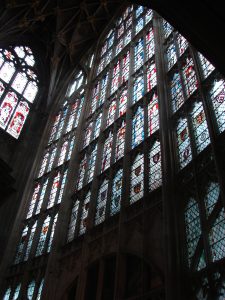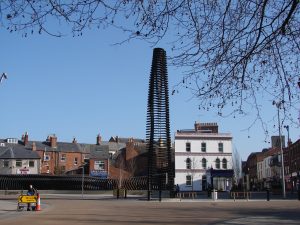After setting my first two Lady Apollonia West Country Mysteries in the village of Aust and the city of Exeter, I chose the ancient city of Gloucester for my third novel, Memento Mori. As with Aust and Exeter, Gloucester also fascinated me because of its great antiquity, many medieval churches, monastic remnants, and Roman origins.
It was necessary for me to learn more about medieval Gloucester before I could begin writing my story, and I was able to accomplish this in several ways. My husband and I took a research trip to the city in 2012 during which I was fortunate to meet a well-known local historian, Philip Moss, whose personal studies and insight were invaluable and whose friendship I cherish to this day. Staff at the tourist information centre, the museums and the library in Gloucester were also extremely helpful, and being on site, I could explore surviving medieval buildings and ancient ruins still in place.
Those medieval survivors, along with the city’s ancient street patterns, allowed me to visualize how the city might have looked in 1392, the year I chose for the setting of Memento Mori. The photo above shows St. Kyneburgh’s tower and wall to its left. The tower is a contemporary construction which marks the location of the medieval wall near the medieval south gate as well as the Chapel of St. Kyneburgh. The tower in the photo shows where St. Kyneburgh’s Well was situated just outside the medieval wall. These locations had a role in my book.
 My husband took many pictures of medieval survivors to help support my memory and my notes. Today’s cathedral in the city was a significant abbey church in the late fourteenth century and still appears, inside and out, much as it would have looked back then. Its great east window, shown on the left, existed in the year of my story, 1392, and still looks as it did when my heroine visited the abbey in my story. There are other medieval churches and monastic ruins referred to in the story which I will mentioned in future postings and will include some pictures as well.
My husband took many pictures of medieval survivors to help support my memory and my notes. Today’s cathedral in the city was a significant abbey church in the late fourteenth century and still appears, inside and out, much as it would have looked back then. Its great east window, shown on the left, existed in the year of my story, 1392, and still looks as it did when my heroine visited the abbey in my story. There are other medieval churches and monastic ruins referred to in the story which I will mentioned in future postings and will include some pictures as well.
Online sources in Exeter had helped me gain information about that ancient city for my second book, Plague of a Green Man, but I couldn’t find anything online which was good for Gloucester until Ian Mortimer, one of my favorite English historians of the medieval period, responded to an email inquiry by suggesting that I try the British History Online. This is the ongoing digitization of a century-long Victorian history project that still is not completed. To help me study Gloucester, this website was a great suggestion and extremely helpful.
Gloucester is located upstream on the River Severn from the village of Aust where my first novel, Effigy of the Cloven Hoof, is set. The Severn River is tidal, and Gloucester is the first city, going upstream from Aust, where the Severn could be forded at low tide or bridged in those days; important for access to Wales in the west. In the 14th Century, Gloucester was an important medieval port city, second only to Bristol in the West Country. Like Aust, it was part of the Diocese of Worchester at that time.
In the next postings, I will focus on the city of Gloucester: its history, ancient churches, and some of its monasteries which play a role in my story; the building which inspired Lady Apollonia’s home in the city, Windemere House; and various important trades in the city, especially wool. Later, my postings will address other topics that arise in Memento Mori such as the plague, Lollardy, and anchorites.
